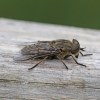Species Account for Thereva plebeja
Thereva plebeja (Linnaeus, 1758)
Diptera: Larger Brachycera: Therevidae
Reproduction for study and non-profit use permitted, all other rights reserved.
Taxonomic group: soldier flies and allies (Diptera: Larger Brachycera) - County data
View time series maps for Thereva plebeja
member log-on for taxon report
Status: NS
Essex RDB: Listed
Threat: Regionally Important
Images
sorry, no pictures available for this species yet - if you have an image please upload itSpecies text
Most records are for southern England but it has been found as far north as Shropshire and near Peterborough. It is clear that even up to the early 1960s it was not unduly scarce in the London area. However in recent years it has become something of a rarity. The decline closely resembles that undergone by many ground nesting aculeates and suggests that changing land use, and in particular reduced areas of disturbed, open habitat, may be largely responsible (Stubbs & Drake 2001). The limited habitat and site information suggests that a range of dry habitats, such as heathland, commons, ruderal and suburban situations can be exploited, with an association with disturbed and usually sandy soil, including that at the top of an estuarine shore. Areas of bare or sparsely vegetated, loose sand and soil should be maintained using mild forms of disturbance as necessary. At some sites, grazing may be important in producing correct situations, especially where limited poaching of the soil is occurring (Falk 1991a). References
Habitats
Recorded management for locations with Thereva plebeja
Recorded substrate and hydrology for locations with Thereva plebeja
Why not join the Club, register and add a new species page
Interpretation of distribution maps


















